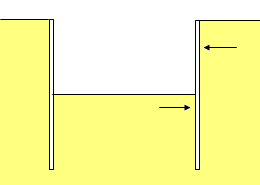Earth pressure
Earth pressure is a term used in geotechnical engineering and is particularly significant for the foundation ( foundation ) of structures and excavations . With regard to the magnitude of the earth pressure, a distinction is made between two extreme cases:
- The active earth pressure is the lowest pressure that a soil of given properties can exert on a structure (e.g. a retaining wall or gabion wall ) of given geometry. This minimum is only achieved if the structure can yield to the pressure within certain limits. Otherwise the loads are higher, one speaks of increased active earth pressure , which is still below the earth pressure at rest.
- The passive earth pressure or earth resistance is the greatest earth pressure with which a soil can support a building wall. It occurs, for example, as earth resistance in the ground in front of the foot of a sheet pile wall clamped in the ground and, in contrast to active earth pressure, counteracts the direction of movement. This maximum generally only occurs when the structure moves in the centimeter or decimeter range.
- Between these two values lies the earth pressure at rest , which applies, among other things, to rigid and immovable structures that are filled from both sides.
The Austrian civil engineer Georg Rebhann (1824-1892) introduced the terms active and passive earth pressure into the German language.
Active earth pressure and passive earth pressure depend u. a. on the following parameters:
density , cohesion and internal angle of friction of the soil, distance from the surface and slope of the terrain , loads (e.g. buildings and vehicles), slope of the building wall and coefficient of friction between soil and wall. If there is groundwater, the water pressure must be treated separately and the weight under buoyancy used for soils in the groundwater.
All other things being equal, the passive earth pressure is significantly greater than the active one. The components of the earth pressure in the horizontal or vertical direction are called horizontal or vertical earth pressure .
history
In France, Vauban first dealt with the earth pressure theory for his fortress retaining walls using rational methods (after Jean Kerisel ), but his memorandum on this ( Profil général de Vauban pour les murs de soutènement ), which he sent to his engineers in 1667, has not survived.
By Pierre Bullet in 1691 the first attempt comes an earth pressure theory. At that time he assumed that the horizontal force from earth pressure on a wall was as great as the weight of a frictionlessly mounted wedge of earth, which is positioned behind the wall at an angle of 45 ° and presses against the wall. The same theory was put forward by Bernard de Bélidor in his 1729 book La science des ingénieurs .
Pierre Couplet des Tortreaux developed a rigid body theory of the vault in 1729/1730 and determined the earth pressure on vaults and walls. His theory was valid up to Coulomb's earth pressure theory.
In 1776, Coulomb proposed an improved theory of earth pressure. In it, an extreme value problem of differential calculus is considered based on the equilibrium of forces on a slipping wedge of earth behind a building wall.
In the 19th century, various graphic processes (for example Jean-Victor Poncelet , Karl Culmann , Georg Rebhann , Christian Otto Mohr , Friedrich Engesser ) were developed. In England Rankine developed an earth pressure theory in 1857. Heinrich Müller-Breslau and Hans Detlef Krey made further improvements in Germany ; Krey's earth pressure tables were widely used from the beginning of the 20th century. In France, Albert Caquot and Jean Kerisel published earth pressure tables in the 1940s, which were built up on non-planar sliding surfaces and which could also be used for passive earth pressure.
literature
- Konrad Simmer: Foundation. Volume 1: Soil Mechanics and Earth Static Calculations. 19th edition. Teubner, 1994, ISBN 3-519-45231-6 .
- Achim Hettler, Karl-Eugen Kurrer : Earth pressure. Ernst & Sohn, Berlin 2019, ISBN 978-3-433-03274-9 .
See also
Web links
- Soil mechanics scripts. Technical University of Munich, including earth pressure
Individual evidence
- ↑ Georg Rebhann: Theory of the earth pressure and the lining walls, with special consideration for the building industry . Carl Gerold's Sohn, Vienna 1871, p. 16-17 .
- ^ Karl-Eugen Kurrer: History of the earth pressure theory . In: History of structural engineering. In search of balance . 2nd, greatly expanded edition. Ernst & Sohn, Berlin 2016, ISBN 978-3-433-03134-6 , pp. 274-379 .
